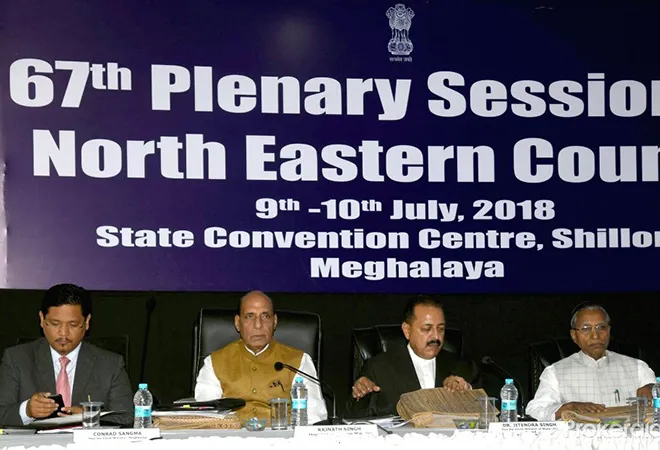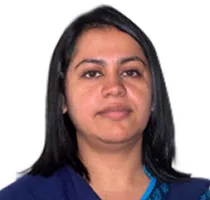
In Shillong recently, Union Home Minister Rajnath Singh chaired the first meeting of the reconstituted North Eastern Council (NEC), the primary coordination body for planning development in the eight north-eastern States. Last month, the Union Cabinet had approved bringing the NEC directly under the Union Home Ministry. Now, the Union Home Minister is the ex-officio chairman of the NEC while the Minister of DoNER (Development of North Eastern Region), who is a state minister with the independent charge, will be the vice chairman. Earlier, the DoNER Minister used to be the chairman of the NEC.
The government has brought this change to fast-track development in the North-Eastern Region (NER). The NEC has Governors and the Chief Ministers of the north-eastern States as its members besides three members nominated by the President of India.
The plenary meeting on 9 and 10 July, in fact the 67th since the inception of the NEC, marked a new journey for the council. The government thinks, with the reconstitution of the NEC with the Union Home Minister as chairman, would provide an effective forum for discussing inter-State matters more comprehensively. Under the new arrangement, the NEC will now also perform the tasks undertaken by various zonal councils pertaining to inter-state issues like drug trafficking, smuggling of arms and ammunition, and boundary disputes. The NEC has been instrumental in setting in motion a new economic endeavour aimed at removing roadblocks to development of the northeastern region.
Development of the North-Eastern region has been a priority for the National Democratic Alliance government. Considering the importance the present central government is giving to the NER, the new arrangement is welcome because experts on the region have been suggesting that development in the region requires a different approach and also participation of all the stakeholders -- the States as well as the Union Government – is crucial.
The NEC comes as a handy option to achieve this goal. It was established in 1972 following the enactment of the North Eastern Council Act of 1971 with an aim to better coordination among the States for the maintenance of internal security and for facilitating planned and integrated development in the region. In spite of sufficient scope to lead development in the region, the NEC’s performance has been less than its potential.
Initially, the NEC played the role of being an advisory body. In 2002, the 1971 Act was amended to make the body more effective. Following the amendment, the NEC became a regional planning body for the NER. Besides, a department of Development of North-Eastern Region (DoNER) was established under the union home ministry. This became a full-fledged ministry in 2004. The NEC has been working under the Ministry of DoNER and its activities include funding various development projects and running educational institutions. There have been suggestions to expand the activities of the NEC, including using it as a forum for discussion on matters of common interest to the region and make recommendations. There were also suggestions to enhance its capacity for conflict resolution so that it can discuss issues of mutual interest to two or more States in the region and advise the central government.
The inclusion of the Union Home Minister as the NEC chairman will help the forum to facilitate better coordination between the Central Government and the State governments in planning development in the region. The change will also emboldens the forum to discuss issues pertaining to Centre-State relations more comprehensively. Empowering the NEC to discuss inter-State matters have become crucial largely because of the existing complexities like the boundary disputes among States that often ignites tension among ethnic communities of the States.
The North-Eastern Region comprises the States of Assam, Arunachal Pradesh, Meghalaya, Manipur, Mizoram, Nagaland, Sikkim and Tripura. The region is home to more than one hundred ethnic communities with many complexities. The region had experienced insurgency for decades and is now walking on the road to peace as the Central Government is engaged in peace talks with various insurgent organizations. The region faces rivalry among ethnic communities and often leads to tensions among the communities that often surpasses the boundaries of one particular State. Besides, the region also has the problem of ethnic groups who are inwardly looking and have been susceptible to outsiders, even people from the other regions of the country. Often, primacy over ethnic identity, culture and customs result in resistance to some of the developmental projects. There is a broad-based notion about the lack of understanding of the region by the policymakers in the region which often make the people of the region to doubt the effectiveness of the policies. All these complexities have been affecting development in the region.
The expectation is that the revamped NEC will be able to address these complexities much better as it will serve as a major bridge among the policymakers of the Centre and the State governments.
The government’s foreign policy goal also appears to have prompted the government to make the new arrangement. The NER shares 90 percent of its boundary with our neighbours -- Bangladesh, Bhutan, China, Myanmar and Nepal -- and hence is strategically important as it serves as the only land link to East Asia, a priority region for India’s foreign policy. Considering the region’s location, it has been termed as India’s gateway to East Asia. Therefore, developing the region is a necessity for the success of India’s East Asia policy. Many of its connectivity projects in South East Asia will be passing through the North-Eastern Region. Also, the development of the region has become important to maintain its position as a regional power, which is now being contested by China. With China launching the Belt & Road Initiative, India is under pressure to make sub-regional initiatives like the BIMSTEC (Bay of Bengal Multi-sectoral Technical and Economic Cooperation) and the BBIN (Bangladesh, Bhutan, India, and Nepal) successful, as many of the members of the BBIN and the BIMSTEC are also members of the BRI. For the success of these initiatives, development of the region is crucial.
In view of the above, the revamping of the NEC was a timely move. Given the ground realities, the NEC reconstitution should not be seen as the ultimate, but rather keep improving the system. An annual meeting of the NEC with the prime minister will help further strengthen the system.
The views expressed above belong to the author(s). ORF research and analyses now available on Telegram! Click here to access our curated content — blogs, longforms and interviews.




 PREV
PREV


